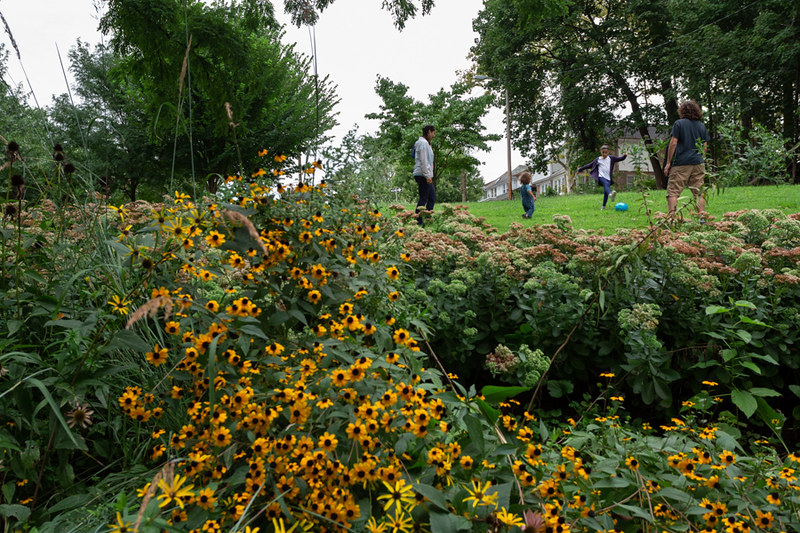@PhillyH2O at Home: We'll be sharing fun at-home activities you can do to stay engaged with water quality issues and science, including learning activities from our Fairmount Water Works educators. Stay tuned and stay safe!
Ready to (safely) get out of the house, join a Philly-based citizen science team, and collaborate with other city-dwellers world-wide?! Try something new with your family and learn about what, and who, is living in your backyard during the Philadelphia City Nature Challenge this weekend. There's even a category for local green stormwater tools.
The City Nature Challenge (CNC), happening April 24th – 27th, is a product of two west coast museums—California Academy of Sciences in San Francisco and Natural History Museum of LA County—challenging each other to a friendly competition focusing on two main ideas: collecting wildlife observations and identifications in urban areas, and engaging urban residents in citizen science.
Originating in 2015, the CNC is now a global event in its fifth year of data collection, and has finally made its way to the parks, gardens, green stormwater tools, and backyards of Philadelphia.
This year’s CNC couldn’t come at a better time. Not just because it comes as we wrap up the 50th anniversary of Earth Day/Week, but because of the drastically reduced human activity, the natural world is blooming, singing, flying, and swimming all around us.
“About half the people in the world live in urban areas, but we still don't know much about urban biodiversity. This is where citizen science efforts like the City Nature Challenge can help bridge the gap by bringing the research to where the people are. Despite having a population of one and a half million in a relatively small area, Philadelphians have observed over 3000 species of wildlife within its borders.”
— Navin Sasikumar, Philadelphia City Nature Challenge Co-Organizer
Participation is very straight forward: download the iNaturalist app on your smart phone, take pictures of what you see (plant, animal, fungi, insect, etc.), and upload your observations. For more details, and some pro-tips on capturing your observations, check out this ‘How to Participate’ guide.
Please be sure you are using best social distancing practices if making observations in public spaces. And don’t forget to use Philly’s own special hashtag when uploading to social media: #iNatThatJawn.
Philly Nature Jawn
Last year marked the first official year of competition for Philly (check out the 2019 leaderboard), and our science-loving residents turned out in force.
Heading outside to identify species using the iNaturalist app, residents of all skill levels helped elevate us to 16th in total number observers, 23rd in total number of observations, and 24th in total number of species documented (out of 159 cities world-wide!).
As we know here at the Water Department, the best complement to healthy waterways is urban green space, including our green stormwater infrastructure (GSI) sites built through our Green City, Clean Waters program. Designed to capture and store stormwater runoff, our GSI, or ‘green tools,’ fit in so well with the City Nature Challenge because we use exclusively native flowers, grasses, shrubs, and trees in our stormwater management practices.

A rain garden with black-eyed susans is a place for families to relax, pollinators to pollinate, and storm water to evaporate.
This is critical for two reasons: the native plant species chosen for our GSI thrive in this climate and these local growers act as hosts for native insects and animals.
The next step toward solidifying the relationship between native plants in our GSI, native insects and animals, and the CNC, was to create a platform specifically designed for observations in our larger pieces of green infrastructure. With the creation of the Philadelphia Green Stormwater Infrastructure (GSI) page we can catalog all the observations at/in our green tools, both specifically for the City Nature Challenge collaboration and throughout the rest of the year.
“Rain gardens and GSI across the city not only help us soak up excess rain water, they also provide critical green space in some of the most developed neighborhoods in Philadelphia. These gardens – some several acres in size, some the size of a single parking space – are typically planted with great, native flowers and shrubs, just the right species our native wildlife and pollinators are looking for. By introducing native plants through these features, we're effectively reintroducing bits of Philadelphia's natural history.” — Robin Irizarry, Philadelphia City Nature Challenge organizing committee member and Alliance for Watershed Education of the Delaware River Fellowship Coordinator
Not only will your observations in our GSI help you learn about this novel type of tool, it will also become a subset of a larger data collection providing even more evidence that green approaches to stormwater management have powerful secondary benefits.
Our valued partners are also getting in on the action: check out the TTF Watershed Partnership page or the Cobbs Creek Watershed page for more inspiration.
If you border the Fairmount Park area, you can also compete to win prizes, including an extra swaggy fanny pack!
We would be very humbled if you were to tag @PhillyH2O in your GSI observations with #CleanWatersPHL…happy snapping!
